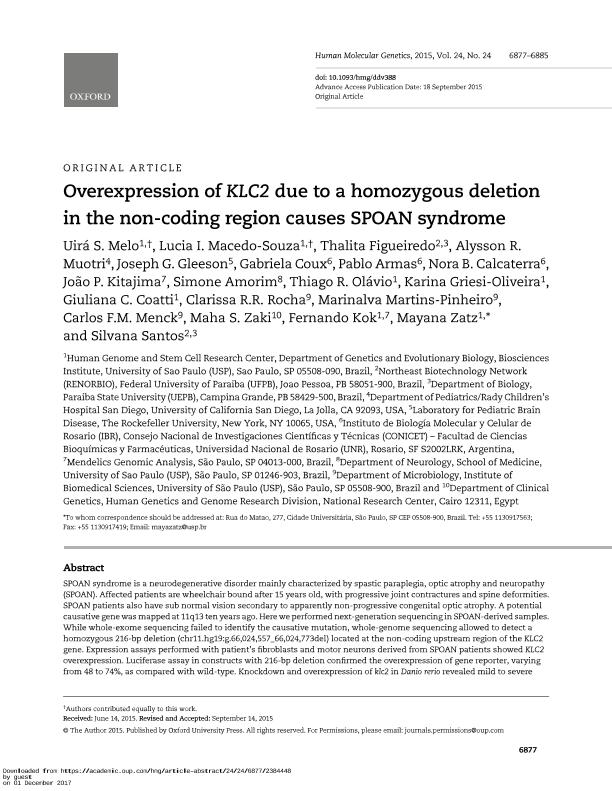Artículo
Overexpression of KLC2 due to a homozygous deletion in the non-coding region causes SPOAN syndrome
Melo, Uira S.; Macedo Souza, Lucia I.; Figueiredo, Thalita; Muotri, Alysson R; Gleeson, Joseph G.; Coux, Gabriela ; Armas, Pablo
; Armas, Pablo ; Calcaterra, Nora Beatriz
; Calcaterra, Nora Beatriz ; Kitajima, João P.; Amorim, Simone; Olávio, Thiago R.; Griesi Oliveira, Karina; Coatti, Giuliana C.; Rocha, Clarissa R.R; Martins Pinheiro, Marinalva; Menck, Carlos F.M.; Zaki, Maha S.; Kok, Fernando; Zatz, Mayana; Santos, Silvana
; Kitajima, João P.; Amorim, Simone; Olávio, Thiago R.; Griesi Oliveira, Karina; Coatti, Giuliana C.; Rocha, Clarissa R.R; Martins Pinheiro, Marinalva; Menck, Carlos F.M.; Zaki, Maha S.; Kok, Fernando; Zatz, Mayana; Santos, Silvana
 ; Armas, Pablo
; Armas, Pablo ; Calcaterra, Nora Beatriz
; Calcaterra, Nora Beatriz ; Kitajima, João P.; Amorim, Simone; Olávio, Thiago R.; Griesi Oliveira, Karina; Coatti, Giuliana C.; Rocha, Clarissa R.R; Martins Pinheiro, Marinalva; Menck, Carlos F.M.; Zaki, Maha S.; Kok, Fernando; Zatz, Mayana; Santos, Silvana
; Kitajima, João P.; Amorim, Simone; Olávio, Thiago R.; Griesi Oliveira, Karina; Coatti, Giuliana C.; Rocha, Clarissa R.R; Martins Pinheiro, Marinalva; Menck, Carlos F.M.; Zaki, Maha S.; Kok, Fernando; Zatz, Mayana; Santos, Silvana
Fecha de publicación:
09/2015
Editorial:
Oxford University Press
Revista:
Human Molecular Genetics
ISSN:
0964-6906
Idioma:
Inglés
Tipo de recurso:
Artículo publicado
Clasificación temática:
Resumen
SPOAN syndrome is a neurodegenerative disorder mainly characterized by spastic paraplegia, optic atrophy and neuropathy (SPOAN). Affected patients are wheelchair bound after 15 years old, with progressive joint contractures and spine deformities. SPOAN patients also have sub normal vision secondary to apparently non-progressive congenital optic atrophy. A potential causative gene was mapped at 11q13 ten years ago. Here we performed next-generation sequencing in SPOAN-derived samples. While whole-exome sequencing failed to identify the causative mutation, whole-genome sequencing allowed to detect a homozygous 216-bp deletion (chr11.hg19:g.66,024,557_66,024,773del) located at the non-coding upstream region of the KLC2 gene. Expression assays performed with patient’s fibroblasts and motor neurons derived from SPOAN patients showed KLC2 overexpression. Luciferase assay in constructs with 216-bp deletion confirmed the overexpression of gene reporter, varying from 48 to 74%, as compared with wild-type. Knockdown and overexpression of klc2 in Danio rerio revealed mild to severe curly-tail phenotype, which is suggestive of a neuromuscular disorder. Overexpression of a gene caused by a small deletion in the non-coding region is a novel mechanism, which to the best of our knowledge, was never reported before in a recessive condition. Although the molecular mechanism of KLC2 up-regulation still remains to be uncovered, such example adds to the importance of non-coding regions in human pathology
Archivos asociados
Licencia
Identificadores
Colecciones
Articulos(IBR)
Articulos de INST.DE BIOLOGIA MOLECULAR Y CELULAR DE ROSARIO
Articulos de INST.DE BIOLOGIA MOLECULAR Y CELULAR DE ROSARIO
Citación
Melo, Uira S.; Macedo Souza, Lucia I.; Figueiredo, Thalita; Muotri, Alysson R; Gleeson, Joseph G.; et al.; Overexpression of KLC2 due to a homozygous deletion in the non-coding region causes SPOAN syndrome; Oxford University Press; Human Molecular Genetics; 24; 24; 9-2015; 6877-6885
Compartir
Altmétricas



